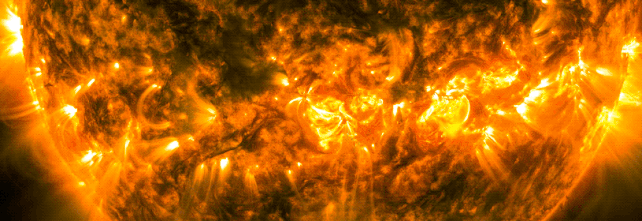The Sun has recently unleashed the mightiest solar flare observed in seven years. On October 3, an X9.0-class flare erupted at the center of the solar disk. Intriguingly, this was paired with a "halo coronal mass ejection" – a phenomenon where solar plasma is hurled directly toward Earth.
This marks the second X-class flare in October 2024, both originating from the same hyperactive sunspot cluster, and it’s the most potent since September 2017, when the Sun discharged a record-breaking X11.88 flare.
Solar flares are currently prolific as the Sun reaches the peak of its 11-year activity cycle, releasing eruptions almost daily since early 2022. While most are minor outbursts, there has been a clear rise in X-class flares, which represent the most energetic category measurable.
The October 3 X9.0 flare ranks among the top 20 strongest ever recorded.
ANOTHER BLAST FROM THE SUN! (NASA/SDO)
The eruption originated from sunspot region AR 3842, characterized by a particularly intricate magnetic setup, classified as 'Beta-Gamma-Delta.'
Sunspots are dark regions where the magnetic field is abnormally intense. These areas are chaotic, as magnetic field lines with opposing polarities collide, twist, and eventually reconnect, unleashing a surge of energy known as a solar flare.
Beta-Gamma regions host areas of opposing polarity that are difficult to merge. Delta classifications occur when opposing polarities are crammed into tight proximity, increasing the likelihood of frequent and severe solar eruptions. This is evident with AR 3842, which produced an X7.1-class flare on October 1 before escalating to the X9.0 eruption.
EARTHLY IMPACTS OF SOLAR FLARES
Earth's surface is shielded from the harmful effects of solar flares due to the atmosphere blocking X-ray and gamma radiation. However, these intense outbursts can temporarily disrupt high-frequency radio communication systems.
The greatest disruptions occur when a coronal mass ejection (CME) accompanies a flare. A CME involves the ejection of billions of tons of solar particles and twisted magnetic fields into the Solar System. When these particles interact with Earth's magnetosphere, they generate geomagnetic storms with a variety of impacts:
- Power grids may experience fluctuations, requiring voltage adjustments.
- Satellites encounter increased atmospheric drag, necessitating orbital corrections.
- GPS and communication systems can face temporary disruptions.
Though a single CME, even paired with a strong flare, is unlikely to cause catastrophic damage, it often creates dazzling auroras visible as far south as 50 degrees latitude.
THE MAGIC OF AURORAS
Auroras arise when solar particles collide with Earth’s magnetic field and funnel along magnetic lines toward the poles, where they are funneled into the upper atmosphere. These interactions cause atmospheric particles to ionize, releasing energy as light. The resulting colors depend on atmospheric composition, akin to the process that powers neon lights, but on a grand cosmic scale.
Already on aurora alert from the X7.1 flare and its accompanying CME, we’re poised to see breathtaking displays. Halo CMEs directed at Earth amplify the auroral intensity, and the NOAA has forecasted several days of peak conditions.
Some of the most intense geomagnetic storms occur during "cannibal CMEs," when two closely spaced CMEs collide, magnifying their impact. Although the current CMEs are spaced too far apart for this scenario, aurora visibility remains high through the weekend.
Skywatchers, this is your cue: prepare to witness one of nature's most spectacular phenomena!
















No comments